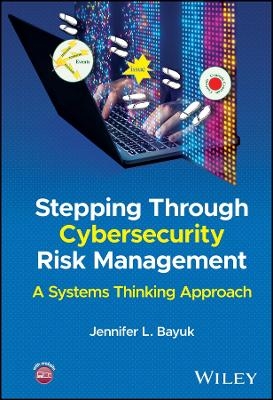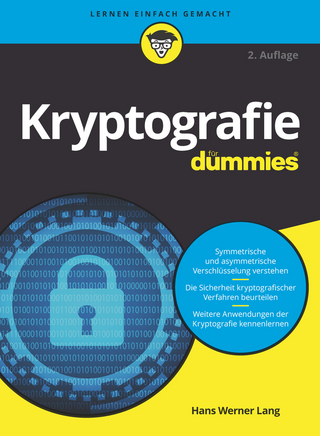
Stepping Through Cybersecurity Risk Management
John Wiley & Sons Inc (Verlag)
978-1-394-21395-5 (ISBN)
Stepping Through Cybersecurity Risk Management covers the professional practice of cybersecurity from the perspective of enterprise governance and risk management. It describes the state of the art in cybersecurity risk identification, classification, measurement, remediation, monitoring and reporting. It includes industry standard techniques for examining cybersecurity threat actors, cybersecurity attacks in the context of cybersecurity-related events, technology controls, cybersecurity measures and metrics, cybersecurity issue tracking and analysis, and risk and control assessments.
The text provides precise definitions for information relevant to cybersecurity management decisions and recommendations for collecting and consolidating that information in the service of enterprise risk management. The objective is to enable the reader to recognize, understand, and apply risk-relevant information to the analysis, evaluation, and mitigation of cybersecurity risk. A well-rounded resource, the text describes both reports and studies that improve cybersecurity decision support.
Composed of 10 chapters, the author provides learning objectives, exercises and quiz questions per chapter in an appendix, with quiz answers and exercise grading criteria available to professors.
Written by a highly qualified professional with significant experience in the field, Stepping Through Cybersecurity Risk Management includes information on:
Threat actors and networks, attack vectors, event sources, security operations, and CISO risk evaluation criteria with respect to this activity
Control process, policy, standard, procedures, automation, and guidelines, along with risk and control self assessment and compliance with regulatory standards
Cybersecurity measures and metrics, and corresponding key risk indicators
The role of humans in security, including the “three lines of defense” approach, auditing, and overall human risk management
Risk appetite, tolerance, and categories, and analysis of alternative security approaches via reports and studies
Providing comprehensive coverage on the topic of cybersecurity through the unique lens of perspective of enterprise governance and risk management, Stepping Through Cybersecurity Risk Management is an essential resource for professionals engaged in compliance with diverse business risk appetites, as well as regulatory requirements such as FFIEC, HIIPAA, and GDPR, as well as a comprehensive primer for those new to the field.
A complimentary forward by Professor Gene Spafford explains why “This book will be helpful to the newcomer as well as to the hierophants in the C-suite. The newcomer can read this to understand general principles and terms. The C-suite occupants can use the material as a guide to check that their understanding encompasses all it should.”
Jennifer L. Bayuk is a cybersecurity due diligence expert with a MS in Computer Science and a PhD in Systems Engineering. She has been a Global Financial Services Technology Risk Management Officer, a Wall Street Chief Information Security Officer, a Big 4 Information Risk Management Consultant, a Manager of Information Technology Internal Audit, a Security Architect, a Bell Labs Security Software Engineer, a Professor of Systems Security Engineering, and a Private Cybersecurity Investigator and Expert Witness
Foreword ix
Preface xiii
Acknowledgements xxv
About the Companion Website xxvii
1 Framework Elements 1
References 16
2 Threats 17
2.1 Threat Actors 17
2.1.1 Hackivists 22
2.1.2 Insiders 23
2.1.3 Hacker 26
2.1.4 Competitors 29
2.1.5 Lone Wolf 33
2.2 Threat Networks 33
2.2.1 Example: Identity Theft 34
2.2.2 Zero-Day Threats 35
2.3 Threat Vectors 37
References 44
3 Events 47
3.1 Event Classification 50
3.2 Event Prevention 56
3.3 Detection and Response 65
3.4 Event Scenarios 77
References 87
4 Controls 89
4.1 Risk Appetite 91
4.2 Policy 94
4.2.1 Security Principles 96
4.2.2 Formality 102
4.3 Process 106
4.4 Standards 114
4.4.1 Internal Standards 114
4.4.2 External Standards 116
4.4.3 Security Architecture 123
4.5 Procedures 130
4.6 Guidelines 136
References 140
5 Assessments 143
5.1 Standards Adherence 147
5.2 Risk and Control Self Assessment 154
5.3 Pentests and Vulnscans 160
5.4 Audits 165
5.5 Spot Checks 169
References 172
6 Issues 173
6.1 Issue Identification 174
6.2 Classification 177
6.3 Criteria and Remediation 180
References 183
7 Metrics 185
7.1 Measuring Cybersecurity 186
7.2 From Measures to Metrics 189
7.3 Key Risk Indicators 205
References 216
8 People 217
8.1 Three Lines of Defense 217
8.2 The Cybersecurity Team 224
8.3 Enterprise Management 230
8.4 Framework Element Owners 233
References 235
9 Risks 237
9.1 Risk Categories 239
9.2 Risk Treatment 242
9.2.1 Controls 242
9.2.2 Transfer 242
9.2.3 Avoidance 245
9.2.4 Acceptance 245
9.3 Risk Appetite 250
9.4 Risk Tolerance 255
9.5 Probability Measurement 260
References 266
10 Analysis 269
10.1 Reports and Studies 269
10.2 Safety Analogies 275
10.3 Decision Support 278
10.4 Conclusion 280
References 282
Appendix: Exercises in FrameCyber 283
Index 299
| Erscheinungsdatum | 07.03.2024 |
|---|---|
| Verlagsort | New York |
| Sprache | englisch |
| Gewicht | 735 g |
| Themenwelt | Mathematik / Informatik ► Informatik ► Netzwerke |
| Informatik ► Theorie / Studium ► Kryptologie | |
| Wirtschaft ► Betriebswirtschaft / Management | |
| ISBN-10 | 1-394-21395-6 / 1394213956 |
| ISBN-13 | 978-1-394-21395-5 / 9781394213955 |
| Zustand | Neuware |
| Haben Sie eine Frage zum Produkt? |
aus dem Bereich


